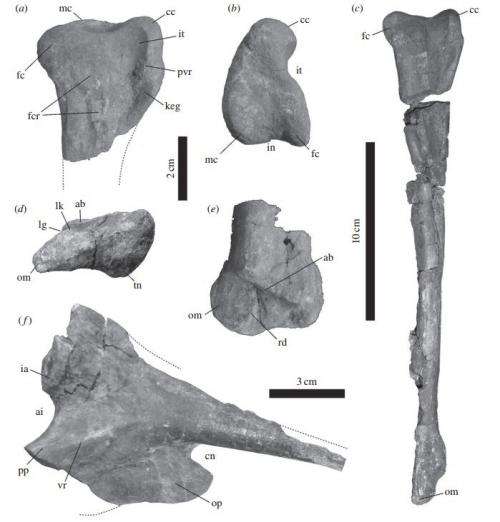October 8, 2014 report
New dinosaur species unearthed in Venezuela

(Phys.org) —A team of paleontologists with members from Brazil, Venezuela, the U.S. and Germany has found fossil evidence of a previously unknown dinosaur in Venezuela. In their paper published in the journal Royal Society Open Science, the team describes how they found the fossils and where they fit into the historical record.
Because the bone fossils were found in the Venezuelan state of Tachira the dino has been named Tachiraptor admirabilis, a relatively small dinosaur believed to have measured just 1.5 meters from the tip of its nose to the end of its tail. The research team believes the bones date to approximately 201 million years ago. That would put the creature that left them behind as living just a million years after the mass extinction that marked the conclusion of the Triassic period and the beginning stages of the Jurassic.
Analysis of the fossils, two leg bones (from two different creatures), suggest the new dinosaur was a bipedal theropod—a meat eating predator. The fossil specimens were found embedded in solid rock that was originally sediment. Prior research suggests the area was likely volcanic during the time T. admirabilis was chasing prey—part of a rift valley that was itself part of Gondwana, a leftover piece of the supercontinent Pangaea. The researchers believe the new dinosaur was likely an ancestor to the familiar and much larger dinosaurs of the later Jurassic, such as T. Rex.
In addition to establishing the existence of a new dinosaur, the find in Venezuela is unique because very few ancient fossils of any kind have been found in the area, mainly due, the researchers note, to little work being done. Unlike other fossil rich areas, sites in the northern part of South America are covered with lush vegetation making it not only difficult to figure out where to dig, but to get to them, and carry out excavations. The recent fossil finds only came about due to road digging efforts. That is changing, however, just this past summer another team found fossil evidence nearby of Laquintasaura, a grass eating creature that was believed to live in herds, and which likely was a prey for T. admirabilis as it appears they were alive during the same time period.
The researchers are hoping that more research in the area and others like it that have not been investigated, will help flesh out the dinosaur family tree.
More information: New dinosaur (Theropoda, stem-Averostra) from the earliest Jurassic of the La Quinta formation, Venezuelan Andes, Royal Society Open Science, rsos.royalsocietypublishing.or … /10.1098/rsos.140184
Journal information: Royal Society Open Science
© 2014 Phys.org


















